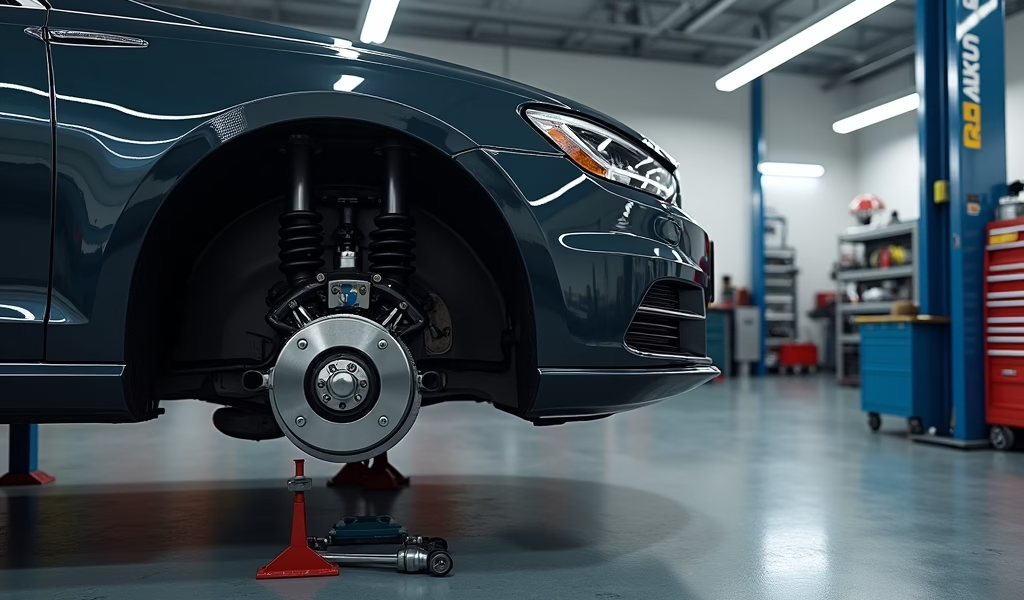Overview
This article explains how combination valves work as critical components in vehicle brake systems, integrating pressure differential switches, metering valves, and proportioning valves to optimize braking performance and safety. It provides practical maintenance tips including regular brake fluid changes, proper bleeding techniques, and warning signs of valve failure, while emphasizing that timely replacement of failing combination valves is essential for vehicle safety.
Table of Contents
- Understanding the Combination Valve
- Function and Purpose of the Combination Valve
- 5 Best Tips for Optimal Combination Valve Operation
- Diagnosing Combination Valve Issues
- Maintenance Practices for Longevity
- When to Consider Replacement
- Conclusion
- Frequently Asked Questions
Understanding the Combination Valve
The combination valve is one of those unsung heroes in your vehicle’s braking system that rarely gets the attention it deserves. As a critical component of your car’s hydraulic brake system, understanding combination valve operation can be the difference between safe driving and potential brake failure. This often-overlooked component serves multiple functions in a single, compact unit – hence the name “combination.”
In my 25 years of working under the hood, I’ve seen countless drivers struggle with brake issues that could have been prevented with a basic understanding of how these valves work. The combination valve typically incorporates two or three separate valve functions: a pressure differential switch, a metering valve, and in many vehicles, a proportioning valve. Each of these elements plays a crucial role in ensuring your vehicle stops safely and predictably.
Think of the combination valve as the traffic controller for your brake fluid. It manages the flow and pressure of brake fluid throughout the system, helping to optimize braking performance in various driving conditions. When functioning correctly, you’ll never even know it’s there. But when problems arise, you’ll certainly notice the difference in your vehicle’s braking capability.
Function and Purpose of the Combination Valve
Let’s break down what this valve actually does. The combination valve houses multiple functions that are essential to proper brake system operation. First, the pressure differential switch monitors the hydraulic pressure between your front and rear brake circuits. If there’s a significant pressure difference (indicating a leak or failure in one circuit), it triggers your brake warning light – giving you a critical heads-up that something’s wrong.
The metering valve component comes into play during initial brake application. It temporarily holds back pressure to the front brakes, allowing the rear brakes to engage first. This might sound counterintuitive, but it prevents front-end dive during light braking, providing more stable and controlled stops. Once sufficient pressure builds, the metering valve opens fully to allow normal front brake operation.
Perhaps most important is the proportioning valve function, which modulates the pressure between front and rear brakes. Since weight transfers forward during braking, this valve reduces pressure to the rear brakes to prevent lockup – a critical safety feature, especially in vehicles without ABS. The proportioning valve ensures your car stops in a straight line rather than spinning out of control.
According to research from the National Highway Traffic Safety Administration, properly functioning brake systems can reduce stopping distances by up to 30% compared to compromised systems. The combination valve plays a direct role in this performance improvement by optimizing brake force distribution.

5 Best Tips for Optimal Combination Valve Operation
Based on my years in the shop, here are my top five tips for maintaining proper combination valve operation and extending its service life:
1. Regular Brake Fluid Maintenance
The single best thing you can do for your combination valve is to flush and replace your brake fluid according to manufacturer recommendations – typically every 2-3 years. Brake fluid is hygroscopic, meaning it absorbs moisture from the air over time. This moisture can cause internal corrosion in the combination valve, leading to sticking or complete failure.
I’ve seen perfectly good combination valves ruined by old, contaminated fluid. Fresh DOT-approved brake fluid not only protects your valve but ensures proper hydraulic pressure throughout the system. When replacing fluid, be sure to bleed the system thoroughly to remove all air bubbles.
2. Pay Attention to Warning Signs
Your car will usually tell you when the combination valve isn’t happy. If your brake warning light illuminates, don’t ignore it! This often indicates the pressure differential switch has detected an issue. Other warning signs include uneven braking, premature rear wheel lockup, excessive front-end dive during braking, or increased stopping distances.
I once had a customer ignore his brake warning light for weeks because “the brakes felt fine.” When he finally came in, we discovered a slow leak in the rear circuit that had been detected by the combination valve. Had he continued driving, complete rear brake failure would have been inevitable.
3. Proper Bleeding Technique
When servicing your brake system, proper bleeding technique is crucial for combination valve operation. Always follow the manufacturer’s specified bleeding sequence, which typically starts with the brake furthest from the master cylinder. Incorrect bleeding can leave air trapped in the system, causing the combination valve to function improperly.
For vehicles with ABS systems, consider having a professional perform the bleeding procedure, as special equipment may be needed to fully purge air from these complex systems. This isn’t just mechanic talk to get your business – I’ve seen countless DIY bleeding jobs lead to ongoing brake issues because air remained trapped near the combination valve.
4. Keep the System Clean
Contamination is the enemy of proper valve function. When working on any part of the brake system, cleanliness is absolutely critical. Even tiny particles can lodge in the delicate internal components of the combination valve, causing erratic operation or complete failure.
Always use fresh, unopened brake fluid from a sealed container, and never reuse old fluid. Clean all fittings and connections thoroughly before opening the system, and keep all components covered when not actively working on them. In my shop, we have a strict “clean hands, clean tools, clean work area” policy for brake work – and it pays off in reliable repairs.
5. Adjust Related Components Properly
The combination valve works in concert with other brake system components. Ensuring proper adjustment of these related parts is essential for optimal valve operation. For example, properly adjusting your load sensing valve if equipped will prevent unnecessary stress on the proportioning function of your combination valve.
Similarly, maintaining proper brake pad-to-rotor clearance and ensuring rear drum brake adjusters are functioning correctly will help the combination valve do its job effectively. Think of your brake system as an orchestra – each component must be in tune for the whole system to perform properly.
Diagnosing Combination Valve Issues
Diagnosing problems with your combination valve requires a systematic approach. First, verify that the brake warning light circuit is functioning correctly. If the light remains on after starting the engine, the pressure differential switch may be detecting a problem, or the switch itself might be faulty.
One effective diagnostic method is to observe brake behavior during controlled stops. If the rear wheels lock up prematurely, especially during moderate braking, the proportioning function may be compromised. Conversely, if the vehicle dives excessively during initial braking, the metering valve portion might be stuck open.
Pressure testing the brake system can provide definitive evidence of combination valve issues. Using a brake pressure gauge at various points in the system allows you to measure the actual pressure differential between front and rear circuits. According to Brake & Front End Magazine, a properly functioning proportioning valve should show approximately 55-70% of master cylinder pressure at the rear wheels during hard braking.
Visual inspection can also reveal problems. Look for signs of external leakage around the valve body or fittings. A leaking valve requires immediate replacement. Also check for corrosion or heat damage, particularly if the valve is mounted near exhaust components.
If you suspect combination valve issues but aren’t seeing obvious signs, consider the age and condition of the brake fluid. Discolored, dark, or particulate-laden fluid suggests internal corrosion that could be affecting valve operation. In my experience, fluid condition is often the smoking gun in mysterious brake performance issues.
Maintenance Practices for Longevity
Preventive maintenance is your best defense against combination valve problems. Beyond regular fluid changes, consider these practices to maximize valve life and performance:
Periodically clean the exterior of the valve and inspect mounting hardware for security. Vibration can loosen mounts over time, leading to stress on brake lines and potential leaks. A quick check during oil changes takes seconds but can prevent major headaches.
For vehicles in corrosive environments (coastal areas or regions that use road salt), consider applying a thin coating of anti-corrosion spray to the exterior of the valve body. Just be careful to avoid getting any on electrical connections or moving parts.
When performing any brake work, take the opportunity to verify the combination valve mounting position. Some valves must be oriented in a specific direction to function properly. I’ve encountered several cases where a valve was installed upside-down during previous repairs, causing erratic brake performance.
If your vehicle has been sitting unused for extended periods, consider a more frequent brake fluid service interval. Stagnant fluid tends to stratify and absorb more moisture, particularly affecting the combination valve which often sits at a low point in the system.
Finally, keep records of brake system service, including fluid type used and service dates. This information is invaluable for troubleshooting and helps ensure proper maintenance intervals are followed. I recommend keeping a small notebook in your glove compartment specifically for tracking maintenance – it’s old school, but it works!

When to Consider Replacement
Combination valves typically last many years, but they’re not lifetime components. Several scenarios warrant replacement rather than attempting to repair the existing valve:
Age alone can be a legitimate reason for replacement. In vehicles over 15 years old, internal seals and components in the combination valve may have deteriorated even without obvious symptoms. Preventive replacement as part of a brake system overhaul can provide peace of mind.
Any external leakage is an immediate replacement trigger. Unlike some components that can function with minor seepage, a leaking combination valve represents a significant safety concern and should never be ignored. The good news is that modern replacement valves often feature improved materials and design compared to original equipment.
If diagnostic testing reveals inconsistent pressure regulation between front and rear circuits (beyond manufacturer specifications), replacement is usually the most reliable solution. Attempting to clean or rebuild these precision components rarely restores proper operation, and the consequences of failure are too serious to risk.
When shopping for a replacement valve, consider OEM (Original Equipment Manufacturer) parts for the most reliable fit and function. While aftermarket options may be less expensive, they sometimes lack the precise calibration of original equipment. As Motor Magazine explains, brake system hydraulics require exacting tolerances to function properly.
During replacement, take the opportunity to inspect and potentially replace connecting brake lines as well. The removal process sometimes reveals hidden corrosion or damage that could lead to future leaks. In my shop, we follow the “while you’re in there” philosophy – addressing potential future problems when the system is already open saves time and money in the long run.
Conclusion
Proper combination valve operation is fundamental to your vehicle’s braking performance and safety. This unassuming component silently manages the complex hydraulics that allow your car to stop smoothly, predictably, and safely in various conditions. By understanding how it works and following the maintenance tips outlined above, you can ensure your combination valve provides years of trouble-free service.
Remember that your brake system is only as strong as its weakest component. Regular maintenance, prompt attention to warning signs, and quality replacement parts when needed are investments in your safety and that of others on the road. The combination valve may not be the most glamorous part of your vehicle, but its proper operation could quite literally be a lifesaver.
Whether you’re a DIY enthusiast or prefer professional service, maintaining awareness of your combination valve’s condition and operation contributes to a safer, more reliable vehicle. Next time you press that brake pedal and come to a smooth, controlled stop, give a little mental thank-you to that hardworking combination valve doing its job perfectly.
Frequently Asked Questions
What exactly does a combination valve do?
A combination valve typically integrates three functions: pressure differential switch (warns of hydraulic failures), metering valve (prevents front-end dive), and proportioning valve (balances front/rear braking force). It optimizes braking performance and safety by managing brake fluid distribution.
How do I know if my combination valve is failing?
Common symptoms include an illuminated brake warning light, uneven braking, premature rear wheel lockup, excessive front-end dive during stops, or increased stopping distances. Any of these warrant immediate inspection by a qualified mechanic.
Can I clean or rebuild my combination valve?
Generally, combination valves are not designed to be rebuilt or cleaned internally. Most professional mechanics recommend replacement with a new unit when problems are detected to ensure safety and reliability.
How often should the combination valve be replaced?
There’s no specified replacement interval as it’s typically a long-lasting component. However, consider preventive replacement during major brake overhauls on vehicles over 15 years old or after significant brake system contamination.
Will a bad combination valve cause my brake pedal to feel soft?
Usually not directly. A soft pedal typically indicates air in the system or master cylinder issues rather than combination valve problems. Combination valve issues more commonly cause uneven braking performance or warning light activation.

